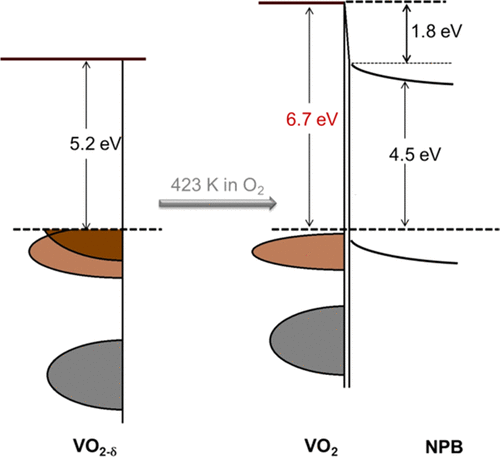当前位置:
X-MOL 学术
›
ACS Appl. Mater. Interfaces
›
论文详情
Our official English website, www.x-mol.net, welcomes your feedback! (Note: you will need to create a separate account there.)
Stoichiometric and Oxygen-Deficient VO2 as Versatile Hole Injection Electrode for Organic Semiconductors
ACS Applied Materials & Interfaces ( IF 9.5 ) Pub Date : 2018-03-19 00:00:00 , DOI: 10.1021/acsami.8b00026 Keke Fu 1 , Rongbin Wang 1, 2 , Takayoshi Katase 3, 4, 5 , Hiromichi Ohta 3 , Norbert Koch 1, 2, 6 , Steffen Duhm 1
ACS Applied Materials & Interfaces ( IF 9.5 ) Pub Date : 2018-03-19 00:00:00 , DOI: 10.1021/acsami.8b00026 Keke Fu 1 , Rongbin Wang 1, 2 , Takayoshi Katase 3, 4, 5 , Hiromichi Ohta 3 , Norbert Koch 1, 2, 6 , Steffen Duhm 1
Affiliation

|
Using photoemission spectroscopy, we show that the surface electronic structure of VO2 is determined by the temperature-dependent metal–insulator phase transition and the density of oxygen vacancies, which depends on the temperature and ultrahigh vacuum (UHV) conditions. The atomically clean and stoichiometric VO2 surface is insulating at room temperature and features an ultrahigh work function of up to 6.7 eV. Heating in UHV just above the phase transition temperature induces the expected metallic phase, which goes in hand with the formation of oxygen defects (up to 6% in this study), but a high work function >6 eV is maintained. To demonstrate the suitability of VO2 as hole injection contact for organic semiconductors, we investigated the energy-level alignment with the prototypical organic hole transport material N,N′-di(1-naphthyl)-N,N′-diphenyl-(1,1′-biphenyl)-4,4′-diamine (NPB). Evidence for strong Fermi-level pinning and the associated energy-level bending in NPB is found, rendering an Ohmic contact for holes.
中文翻译:

化学计量学和缺氧的VO 2作为有机半导体的多功能空穴注入电极
使用光发射光谱法,我们发现VO 2的表面电子结构是由温度依赖的金属-绝缘体相变和氧空位密度决定的,氧空位密度取决于温度和超高真空(UHV)条件。原子清洁和化学计量的VO 2表面在室温下是绝缘的,并且具有高达6.7 eV的超高功函。在高于相变温度以上的UHV中加热会诱发预期的金属相,这与氧缺陷的形成密切相关(在本研究中高达6%),但保持了> 6 eV的高功函数。演示VO 2的适用性作为有机半导体的空穴注入接触,我们研究了与原型有机空穴传输材料N,N'-二(1-萘基)-N,N'-二苯基-(1,1'-联苯)-的能级对准4,4'-二胺(NPB)。找到了牢固的费米能级钉扎和NPB中相关的能级弯曲的证据,从而形成了孔的欧姆接触。
更新日期:2018-03-19
中文翻译:

化学计量学和缺氧的VO 2作为有机半导体的多功能空穴注入电极
使用光发射光谱法,我们发现VO 2的表面电子结构是由温度依赖的金属-绝缘体相变和氧空位密度决定的,氧空位密度取决于温度和超高真空(UHV)条件。原子清洁和化学计量的VO 2表面在室温下是绝缘的,并且具有高达6.7 eV的超高功函。在高于相变温度以上的UHV中加热会诱发预期的金属相,这与氧缺陷的形成密切相关(在本研究中高达6%),但保持了> 6 eV的高功函数。演示VO 2的适用性作为有机半导体的空穴注入接触,我们研究了与原型有机空穴传输材料N,N'-二(1-萘基)-N,N'-二苯基-(1,1'-联苯)-的能级对准4,4'-二胺(NPB)。找到了牢固的费米能级钉扎和NPB中相关的能级弯曲的证据,从而形成了孔的欧姆接触。



























 京公网安备 11010802027423号
京公网安备 11010802027423号